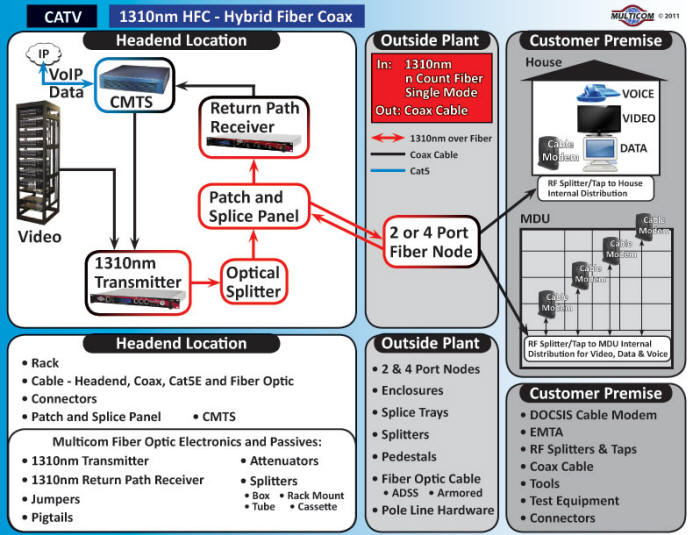HFC is a telecommunications industry term for a broadband network which combines optical fiber and coaxial cable. It has been commonly employed globally by cable TV operators since the early 1990s.
Below is a typical HFC Network. Click the section to view example products.

The fiber optic network extends from the cable operator’s headend out to a neighborhood’s hubsite, and finally to a fiber optic node which serves anywhere from 25 to 2000 homes. A headend will usually have satellite dishes for reception of distant video signals as well as IP aggregation routers. Some headends also house telephony equipment for providing telecommunications services to the community. The headend will receive the video signal and add to it the Public, Educational and/or Governmental channels and encode, modulate and upconvert onto RF carriers, combined onto a single electrical signal and inserted into a broadband optical transmitter. This optical transmitter converts the electrical signal to a downstream optically modulated signal that is sent to the nodes. Fiber optic cables connect the headend to optical nodes in a point-to-point or star topology, or in some cases, in a protected ring topology.
A fiber optic node has a broadband optical receiver which converts the downstream optically modulated signal coming from the headend to an electrical signal going to the homes. Today, the downstream signal is a radio frequency modulated signal that typically begins at 50MHz and ranges from 550MHz to 1000MHz on the upper end. The fiber optic node also contains a reverse/return path transmitter that sends communication from the home back to the headend. This reverse signal is a modulated RF frequency ranging from 5 to 42MHz.
The optical portion of the network provides a large amount of flexibility. If there are not many fiber optic cables to the node, wavelength division multiplexing can be utilized to combine multiple optical signals onto the same fiber. Optical filters are used to combine and split optical wavelengths onto the single fiber. For example, the downstream signal could be on a wavelength at 1550nm and the return signal could be on a wavelength at 1310nm.
